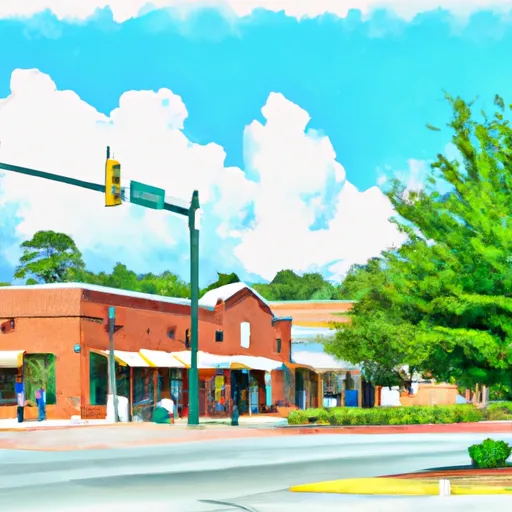-
 Snoflo Premium
Snoflo Premium
Get unlimited access to all our content
With no Ad interruptions! - Start Your Free Trial Login with existing account
Millwood
Eden Index
Climate
8.0
•
Recreation
•
Community
•
Safeguard
3.2/10

Millwood, Georgia is a picturesque town nestled in Ware County, known for its diverse natural beauty and outdoor recreation opportunities. The climate in Millwood is generally warm and humid, with mild winters and hot summers. Average temperatures range from the mid-50s in winter to the high 80s in summer. The area receives a moderate amount of rainfall throughout the year.
Millwood is surrounded by stunning hydrology constituents, including the Okefenokee Swamp and the Satilla River. These water bodies offer a range of activities such as fishing, boating, and kayaking. The Okefenokee Swamp, a vast wilderness of cypress forests and marshes, provides excellent wildlife viewing opportunities, including alligators, turtles, and various bird species. The Satilla River is popular among anglers, who can expect to catch bass, catfish, and bream.
With its abundant natural resources, Millwood offers numerous outdoor recreation opportunities. Visitors can explore hiking and biking trails, go camping in the surrounding parks, or simply enjoy a picnic amidst the beautiful landscapes. Nature enthusiasts will love the opportunity to immerse themselves in the serene and captivating wilderness that Millwood, Georgia has to offer.
What is the Eden Index?
The Snoflo Eden Index serves as a comprehensive rating system for regions, evaluating their desirability through a holistic assessment of climate health, outdoor recreation opportunities, and natural disaster risk, acknowledging the profound impact of these factors on livability and well-being.
Climate Health Indicator (CHI): 8.0
Millwood receives approximately
1241mm of rain per year,
with humidity levels near 85%
and air temperatures averaging around
19°C.
Millwood has a plant hardyness factor of
8, meaning
plants and agriculture in this region tend to thrive here all year round.
By considering the ideal temperature range, reliable water supplies, clean air, and stable seasonal rain or snowpacks, the Climate Health Indicator (CHI) underscores the significance of a healthy climate as the foundation for quality living.
A healthy climate is paramount for ensuring a high quality of life and livability in a region, fostering both physical well-being and environmental harmony. This can be characterized by ideal temperatures, reliable access to water supplies, clean air, and consistent seasonal rain or snowpacks.
Weather Forecast
Streamflow Conditions
St. Marys - Satilla
Area Rivers
St. Marys - Satilla
Snowpack Depths
St. Marys - Satilla
Reservoir Storage Capacity
St. Marys - Satilla
Groundwater Levels
Recreational Opportunity Index (ROI):
The Recreational Opportunity Index (ROI) recognizes the value of outdoor recreational options, such as parks, hiking trails, camping sites, and fishing spots, while acknowledging that climate plays a pivotal role in ensuring the comfort and consistency of these experiences.
Access to outdoor recreational opportunities, encompassing activities such as parks, hiking, camping, and fishing, is crucial for overall well-being, and the climate plays a pivotal role in enabling and enhancing these experiences, ensuring that individuals can engage in nature-based activities comfortably and consistently.
Camping Areas
| Campground | Campsites | Reservations | Toilets | Showers | Elevation |
|---|---|---|---|---|---|
| Towns Bluff County Park | None | 114 ft | |||
| Oleno State Park | None | 77 ft | |||
| Stephen Foster State Park | None | 97 ft | |||
| General Coffee State Park | None | 216 ft | |||
| Ocean Pond | 67 | 162 ft |
Nearby Fishing
Catastrophe Safeguard Index (CSI):
The Catastrophe Safeguard Index (CSI) recognizes that natural disaster risk, encompassing floods, fires, hurricanes, and tornadoes, can drastically affect safety and the overall appeal of an area.
The level of natural disaster risk in a region significantly affects safety and the overall livability, with climate change amplifying these risks by potentially increasing the frequency and intensity of events like floods, fires, hurricanes, and tornadoes, thereby posing substantial challenges to community resilience and well-being.
Community Resilience Indicator (CRI):
The Community Resilience Indicator (CRI) recognizes that education, healthcare, and socioeconomics are crucial to the well-being of a region. The CRI acknowledges the profound impact of these elements on residents' overall quality of life. By evaluating educational resources, healthcare accessibility, and economic inclusivity, the index captures the essential aspects that contribute to a thriving community, fostering resident satisfaction, equity, and social cohesion.

